It’s dinnertime and you’ve had a long day at work, it’s blistering hot in the middle of July, and everyone’s hungry. I’ve been there far too many times before and hate that stumped feeling of not knowing what to do for dinner. One of the biggest saviors for me is throwing some chicken breast in a skillet on the stove and sauteing it until it’s nice and juicy. Sauteing meat is a fast, simple way to prepare a delicious protein to satisfy your hunger cravings.
This post is part of our Basic Cooking Skills series. Each week we will be doing a deep-dive into one basic cooking skill and a brand new recipe to accompany it to practice that newfound skill. Check back throughout the series for updates and new posts.
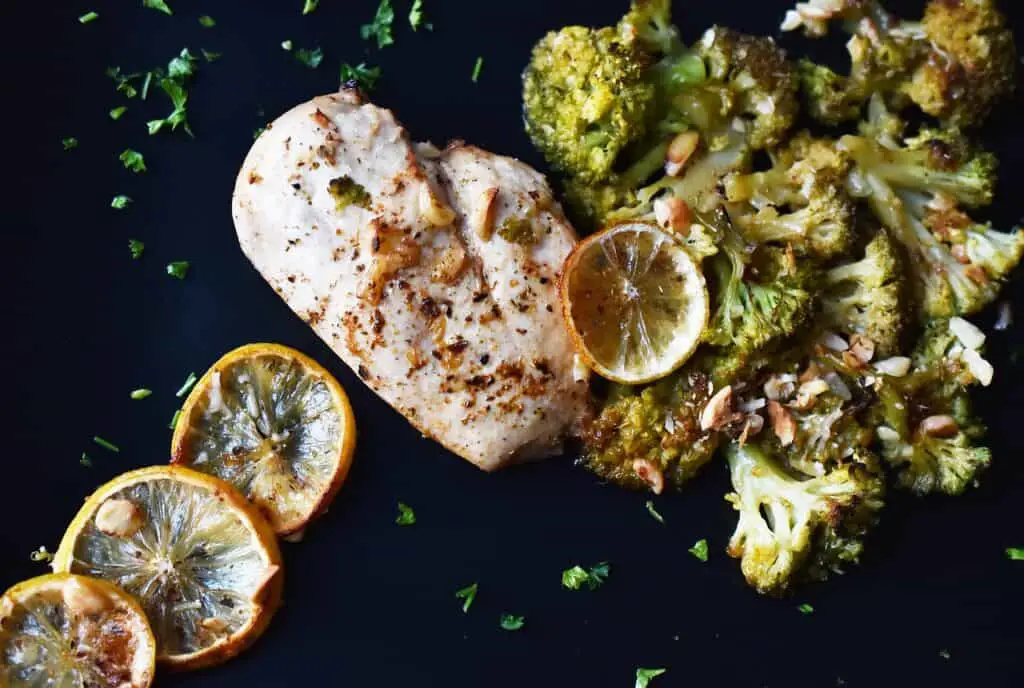
Sauteing Meat: What does it actually mean?
In its simplest form, sauteing is the process of cooking food in a pan with a small amount of fat, whether that be a cooking oil or a slab of butter.
This method of heating is called conduction (which we learned more about in our elements of cooking post here). Fat quickens conduction by browning the food without burning, allowing it to cook fully. This is even more important when it comes to meat, since meat requires a little more time to cook thoroughly.
Various foods saute differently, and for more information on sauteing vegetables check out this post. Overall, sauteing is ideal for foods that are cooked in a short amount of time.
When it comes to cooking meat, poultry, or seafood, you’ll find a variety of terms used interchangeable to refer this method of cooking:
sauteing, searing, pan-frying, browning, and more
But they all basically mean the same thing — a pan on the stove, over medium-high heat, preparing meat with a little bit of oil or butter.
Begin heating up a pan, grab your protein of choice and little fat, and you’re ready to get started.
Sauteing Meat, Poultry, and Seafood Guide
Best Meat to Saute
Sauteing is a very forgiving cooking method, and most proteins can be sauteed with a watchful eye.
Leaner cuts of meat, such as chicken breast, pork chops, and seafood saute best. They require less time and grow more tender from a saute.
Larger cuts of beef or lamb that are generally more tough are usually best prepared with low-and-slow methods and benefit from much longer cooking times.
Best Fat to saute meat
Cooking oils and butter are the classic fats to use when it comes to sauteing. Both have pros and cons depending on your individual goals.
Butter will increase the overall flavor and may be best if you’re trying a protein you’re not very fond of or familiar with.
Cooking oils such as olive oil or canola oil are very all-purpose, inexpensive, and hard to mess up. They provide complementary flavor without overpowering what you’re cooking. Olive oil and avocado oil are also much healthier than butter and are good sources of fat to add into your diet.
One downside to using favorites such as butter or olive oil is that they have fairly low smoke points. When using very high heat they may start to smoke and affect the flavor of the ingredients. Oils with high smoke points can be used for very high heat, such as avocado oil or grapeseed oil.
Best Pan to Saute Meat
When it comes to sauteing, most pans will work just fine. There are, however, a few qualities that help make this cooking process even easier for you.
An ideal pan to saute vegetables has a wide base, straight sides, and distributes heat evenly.
A wide base and straight sides increase the surface area of the pan. More surface area = more room for veggies!
It’s very common for skillets to have slanted sides, and those will work too. Take note that you may not be able to fill it with quite as many vegetables as you would with a straight-sided pan, but that can easily be adjusted and you can do a few rounds instead.
The distribution of heat evenly is essential to simplify the cooking process. A pan with a heavy bottom works best and will cook similar vegetables at similar speeds. If your pan is thin or warped, part of the pan may cook much slower than others and make it difficult to know when each individual piece is fully cooked.
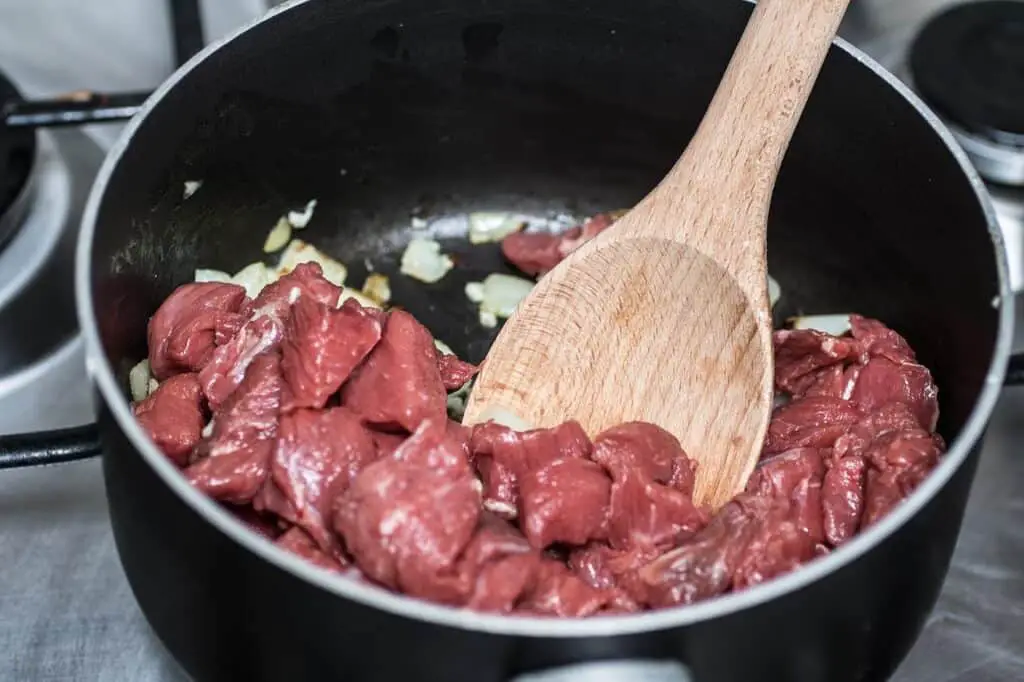
Seasoning Sauteed Meat
When it comes to seasoning meat before sauteeing, less is more!
Sprinkle lightly with salt and pepper to keep it simple yet flavorful. The bulk of your flavor will come from deglazing the pan afterwards!
You may notice as the meat is cooking, crispy little brown bits called “fronds” develop along the bottom of the pan.
They are pockets of great flavor! Deglaze the pan with wine, broth, or even water, to loosen up the bits of frond and incorporate them into your meal. This technique is best when using the pan immediately following it to create a sauce or cook vegetables.
Tips for Sauteing Meat
- This technique works best when the meat is cut into even, bite-sized pieces. Whole cuts of meat will work, but requires more attentiveness on your part.
- Sauteing is a dry heat cooking method. Pat the protein dry before cooking for increased crispness and flavor. The more water present, the less intense flavor.
- When heating the pan, you can test how hot it is by a drop of water in the pan. If it sizzles, the pan is hot enough to saute!
- Only a little bit of fat should be added to the pan. You can always add more if you need to, and pour out an excess if too much.
- Cook in batches to avoid overcrowding the pan. Too many ingredients in the pan can create steam and prevent the meat from browning. Have a plate to the side lined with a paper towel to place the pieces as they finish cooking.
- The key to a good saute is not stirring too much. Allow one side to cook undisturbed before flipping to the other side.
- Yummy bits of frond will develop on the bottom of the pan. Deglaze the pan with wine or broth to lift up the crispy bits from the bottom and incorporate into a sauce or glaze for your meal.
In the comments below, share your favorite kinds of protein to cook after a long day! Mine used to always be chicken breast, but lately I’ve been LOVING shrimp!
Materials Needed
Pin me!
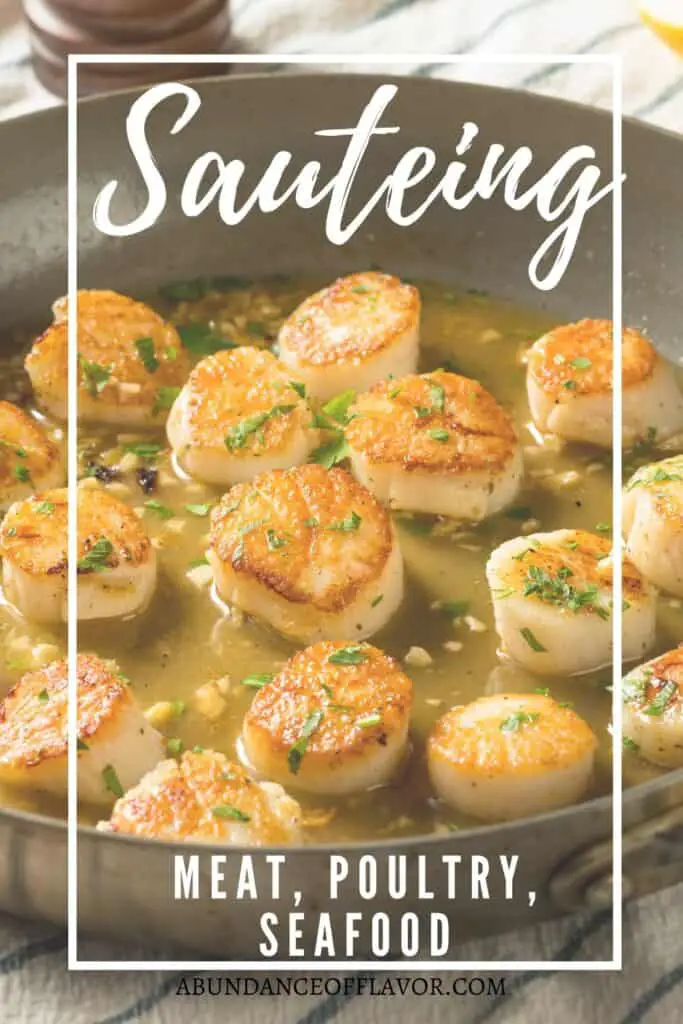
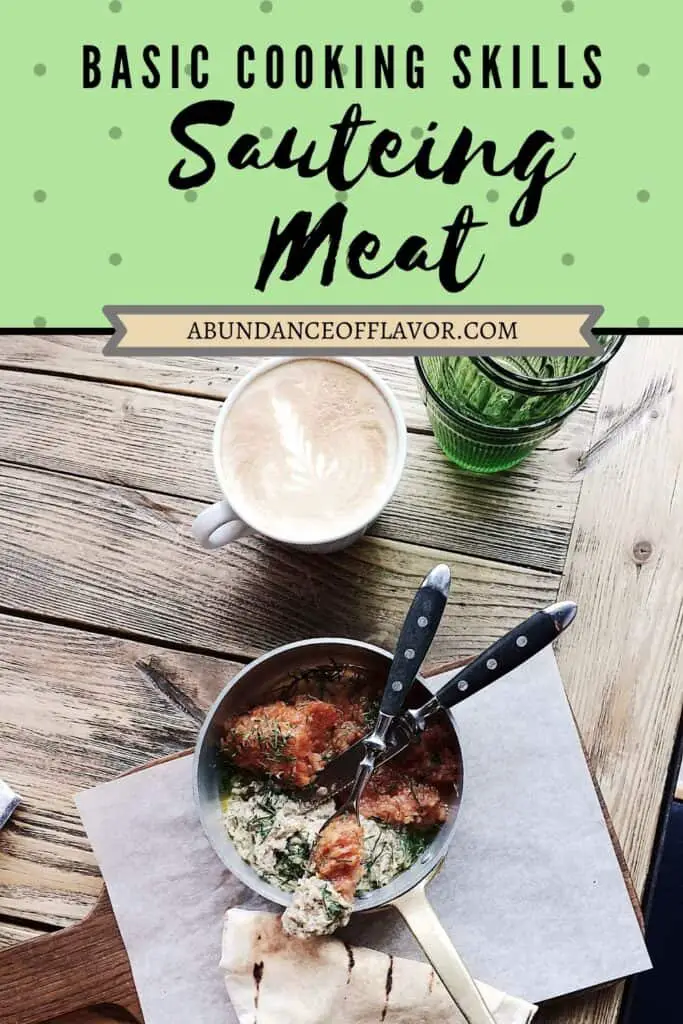
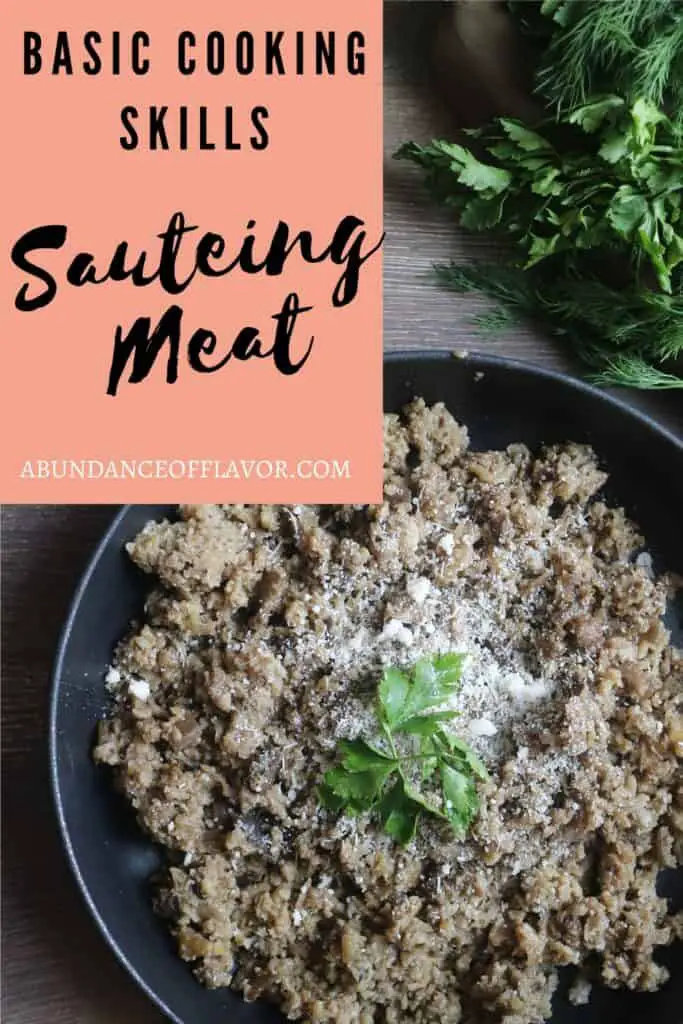
Implement your new skills
I hope you’ve learned something new about fail-proof ways to saute meat, poultry, and seafood. This Thursday I’ll be sharing an AMAZING dish that involves sauteing meat….it’s the best, bar naan 😉
****UPDATE! Check out this recipe for authentic Indian curry and try your sauteing skills on some chicken breasts!



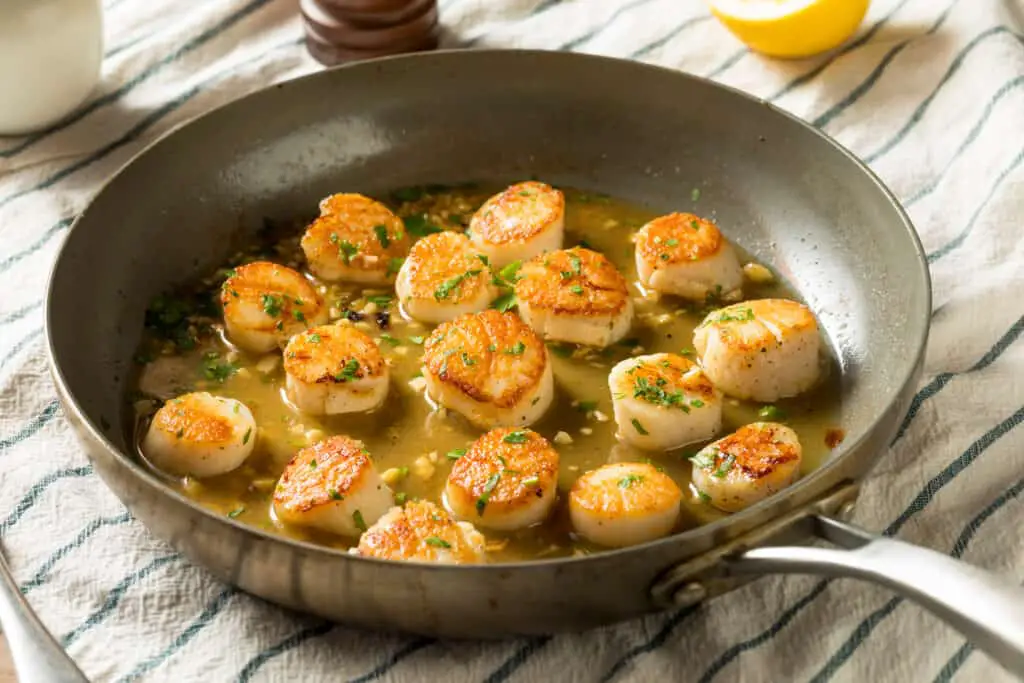
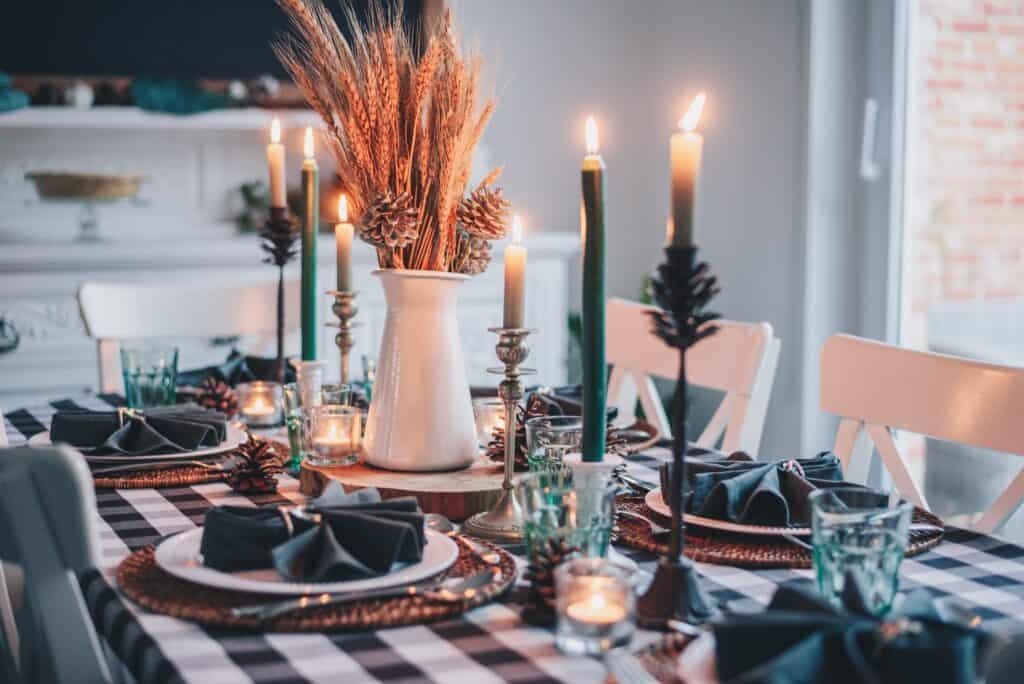
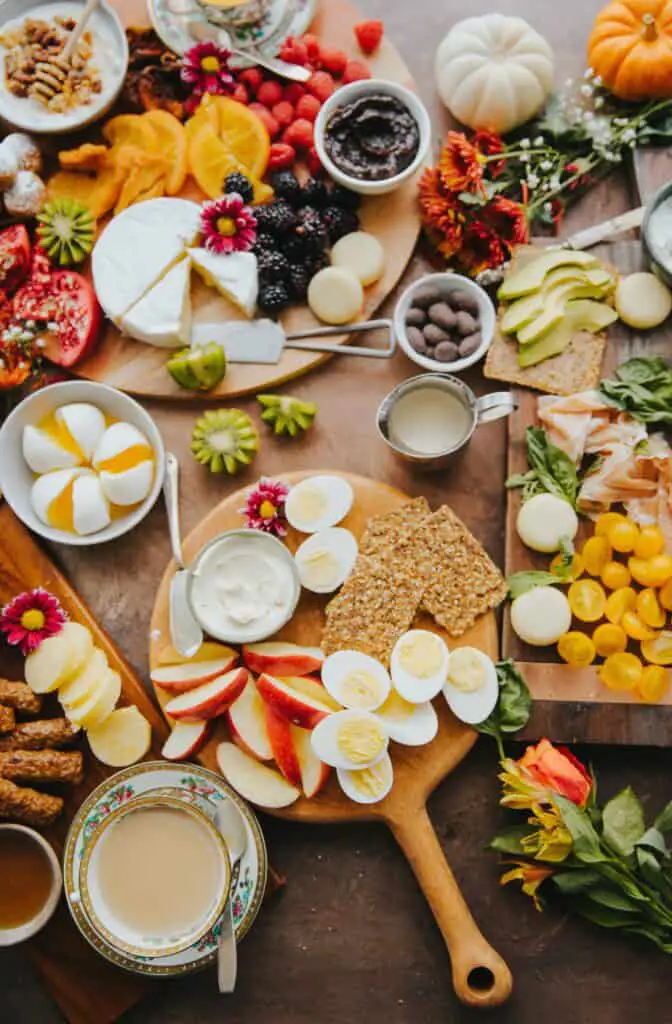

Great tips to keep cooking simple. Thanks for sharing,
Thanks so much 🙂
Great tips and showing how simple it is. Those scallops look delicious
Thanks so much, I’m hoping it’s helpful!
This is such a good tip! I do think I eat quite varied, but using other techniques is smart as well! Definitely going to try this soon!
Sauteing definitely encourages me to try new foods!
As a pescatarian, I’d also say shrimp is my favourite protein to cook with after work but I do like Salmon too.
I love shrimp! Salmon is still pretty new to me but I’ll have to try it again soon 🙂
I definitely need to be better about making sure my meat is dry beforehand. Thanks for sharing!
It takes a little extra time but is worth it! Thanks 🙂
I had no idea what to do with fronds until now (I did know they taste good since I’d scrape it off to eat it though). Thanks again for the series! It’s been helping me progress. x
Aww that’s great! I love the crispy little fronds and they taste so great in a quick sauce
Great tips! I love using a cast-iron skillet for sauteing. If it takes longer I usually just cook it in the oven (I’m just lazy like that).
Cast iron is really great for a deep brown caramelization since it distributes heat so well!
I love my cast iron skillet for steak and chicken. Sautéing is a big part of cooking for me. Its probably the go to method of cooking a good juicy steak or chicken fillet for a chicken burger. So great information, thank you for sharing.
Cast iron works so well to get the caramelization process going!
Great post! Thank you for sharing! This is very useful!
I’m glad! Thanks for commenting!
Great post ! 💕
I use to love sautéing steak using butter Like how you mentioned, a little salt and pepper and thyme.
But now I don’t eat red meat anymore so I usually make flattened chicken breasts with salt and pepper and squeezing a little lemon over the chicken breasts !
Yum those both sound great! Chicken breasts are definitely my go-to now
Great tips – it’s strange to think that people do this most days but don’t even realise what it’s called! I love sautéed chicken and potatoes – it makes for such a delicious meal with some veggies. Thank you for sharing!
Love, Em
Chicken, potatoes and veggies makes for such a wholesome well-rounded meal!
I think you need to produce a cool book, I would certainly buy it. I need to start making some of these fantastic dishes.
That’s so thoughtful, thanks a bunch!
Sauteing is literally my favorite method of cooking. My favorite sauteed food is mushrooms – yes – mushrooms. I could eat so many of them. Lol
Ahh I LOVE mushrooms! I add them to as many meals as possible!
Another one! I always love to go through your tips and recipes. Thanks for sharing this one!!
Thanks so much, I appreciate you checking out my posts!
Thanks for sharing, great tips on basic cookery 🙂 I think the tips is not to make whatever you cook dry 🙂
Nic | Nic’s Adventures & Bakes
YES and that’s so important! Thanks for reading!
Defiantly my favorite cooking blog! You gave the best tips girl!!
That’s so sweet of you, thanks so much!!
Great tips!
Although you have left me drooling over this gorgeous looking food!
Thanks for sharing!
Haha I love, thanks so much!
This is a helpful guide for cooking meats! Thank you!
That’s so good to hear! Thanks for reading!
Great post. Learned a lot in a short time. Definitely pinning this! Thanks for sharing!
Thank you so much! I love that you learned something new
Pingback: Authentic Indian Chicken Curry - Abundance of Flavor
Great tips on sauteing meat and seafood. I use my cast iron skillet the most when sauteing foods.
Every kitchen has a great cast iron skillet! I love mine
Pingback: Making a Sauce - Basic Cooking Skills - Abundance of Flavor
Pingback: 21 Basic Cooking Skills for Beginners - Abundance of Flavor